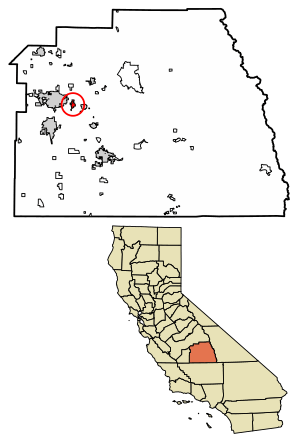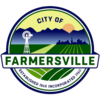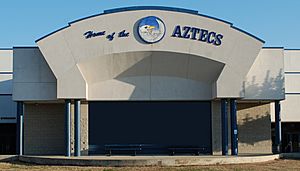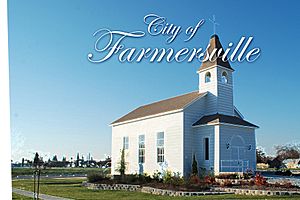Farmersville, California facts for kids
Quick facts for kids
Farmersville, California
|
||
|---|---|---|
|
||
| Motto(s):
"It's Always Sunny in Farmersville"
|
||

Location of Farmersville in Tulare County, California.
|
||
| Country | ||
| State | ||
| County | Tulare | |
| Incorporated | October 5, 1960 | |
| Area | ||
| • City | 2.20 sq mi (5.70 km2) | |
| • Land | 2.20 sq mi (5.70 km2) | |
| • Water | 0.00 sq mi (0.00 km2) 0% | |
| Elevation | 358 ft (109 m) | |
| Population
(2020)
|
||
| • City | 10,397 | |
| • Estimate
(2021)
|
10,382 | |
| • Density | 4,726/sq mi (1,824.0/km2) | |
| • Metro | 473,117 | |
| Time zone | UTC-8 (Pacific) | |
| • Summer (DST) | UTC-7 (PDT) | |
| ZIP code |
93223
|
|
| Area code | 559 | |
| FIPS code | 06-23616 | |
| GNIS feature IDs | 1652709, 2410485 | |
Farmersville is a city in the San Joaquin Valley in Tulare County, California, United States, just to the east of Visalia, California. The population was 10,397 at the 2020 census, down from 10,588 at the 2010 census. The unofficial estimate in 2024 is a population of 12,000.
The city helps support many events throughout the year, including the Memorial Day Parade in May, which is well attended and manages to draw around 4,000 visitors from the surrounding area. In October a Fall Festival is held on the downtown boulevard. In December a Christmas Tree Lighting event is held at the Old Methodist Church building.
Contents
History
The history of Farmersville began in the 1850s. This early community was called Deep Creek, located near the present Deep Creek Cemetery. There are headstones that date back to the 1850s.
Farmersville's first school was built there to accommodate the farm children in the area. In the Fly family history, which is preserved in a book written about their travels to California, there is talk about attending the Deep Creek School in the 1860s. It was located East of the Cemetery.
Until 1863, other residents living on the east side of the county traveled through Farmersville on the Visalia Road. They rode their horse-drawn wagons to get their mail, purchase supplies and bring their goods to sell. The trip was long, so many would stop at the Wiley Hinds farm, just south of present-day Farmersville, to ask to sleep in his barn and continue their trip home the next day. Wiley Hinds was a former slave, and came from Arkansas with his brother, Archibald, in 1858. He settled in Farmersville, purchased other parcels for farming, and became very prosperous.
In 1866 two entrepreneurs, John Crowley and his Uncle Merrill Jasper opened a large general store in Farmersville. They wanted to capture the sales of residents from the east side of the county, on their way to Visalia to get their mail. Unfortunately, they were not successful. In 1868 their nephew and also store manager Thomas J. Brundage, purchased the business from them. During this time the application for a post office and the name of the town were finally approved by the US Government. The store now became much more successful and eastern residents began to stop and pick up their mail. Mr. Brundage also had a lumber yard across the street from the general store. Oxen would pull the lumber shipment from the Sierra hills. Just east of the Brundage General Store was the Brown Hotel. It was constructed in 1870 for Edward Balaam and was later purchased by Charles Brown. The hotel was two stories and served meals to passengers during the horse changeover for the Overland Stage. Brown also owned the livery stable. The location of the Brundage General Merchandise store and the Brown Hotel is near what is now Sam's Foods Supermarket (old Nickel's Payless store), commemorated by a historic granite marker in the parking lot. There was a large fire in 1910 that hit the corner of Visalia Rd and Farmersville Blvd. The Brundage General store received fire damage. The fire also burned a couple of other businesses and buildings and scorched the Methodist Church. This old wooden store was torn down sometime in the 1920's. It was replaced with a Trading Post, it burned down in 1951 and replaced with a Texaco Gas Station, which later became a Beacon Gas station. Today it is an empty lot.
In 1910 Thomas J. Brundage's son, Oscar G. Brundage, who took over the general store decided to build an additional store, this time made of brick. It was completed in December 1910. He continued working in the stores at least until the late 1920s. Later it became Dixon's Grocery Store, owned by Floyd Dixon. After that, it became Ryan's Grocery Store. In the 1940s it became a bar called the Frontier Club. It was finally destroyed in a fire in the 1960s. It sat on the Southeast corner of Visalia Rd and Farmersville Blvd, where Rainbow's Drive In sits today.
In 1945 the town had voted to pay for its own police department. The town had one Police Officer on duty during this time. Before 1960, the town was under the authority of the County. Residents and Chamber of Commerce Officials worked with the County for their needs.
Discussion to incorporate started as early as 1945. Don Freeman began the petition and application process that lead to the city's incorporation on October 5, 1960. The first city council was composed of James Tornow, Mayor, Truman Qualls, Don Freeman, Willis Freeman, and Jim Steven. Carl Waddle was the first City Clerk. Early on the City struggled to get proper water delivery and wastewater treatment. In 1968 the Wastewater treatment plant loan was made for $480,000 to build the first plant and transmission infrastructure. The city residents in 1968 seriously discussed dis-incorporation led by store owner Tom Bray.
Geography
Farmersville is located at 36°18′4″N 119°12′27″W / 36.30111°N 119.20750°W (36.301169, -119.207603).
According to the United States Census Bureau, the city has a total area of 2.3 square miles (6.0 km2), all of it land.
Demographics
| Historical population | |||
|---|---|---|---|
| Census | Pop. | %± | |
| 1960 | 3,101 | — | |
| 1970 | 3,456 | 11.4% | |
| 1980 | 5,544 | 60.4% | |
| 1990 | 6,235 | 12.5% | |
| 2000 | 8,737 | 40.1% | |
| 2010 | 10,588 | 21.2% | |
| 2020 | 10,397 | −1.8% | |
| 2021 (est.) | 10,382 | −1.9% | |
| U.S. Decennial Census | |||
2020
The 2020 United States Census reported that Farmersville had a population of 10,397.
2010
The 2010 United States Census reported that Farmersville had a population of 10,588. The population density was 4,688.2 inhabitants per square mile. The racial makeup of Farmersville was 5,295 (50.0%) White, 60 (0.6%) African American, 213 (2.0%) Native American, 72 (0.7%) Asian, 5 (0.0%) Pacific Islander, 4,494 (42.4%) from other races, and 449 (4.2%) from two or more races. Hispanic or Latino of any race were 8,876 persons (83.8%).
There were 2,595 households, out of which 1,639 (63.2%) had children under the age of 18 living in them, 1,474 (56.8%) were married couples living together, 515 (19.8%) had a female householder with no husband present, 274 (10.6%) had a male householder with no wife present. There were 257 (9.9%) unmarried partnerships, and 10 (0.4%) same-sex couples. 258 households (9.9%) were made up of individuals, and 110 (4.2%) had someone living alone who was 65 years of age or older. The average household size was 4.08. There were 2,263 families (87.2% of all households). The population was spread out, with 3,895 people (36.8%) under the age of 18, 1,234 people (11.7%) aged 18 to 24, 2,941 people (27.8%) aged 25 to 44, 1,822 people (17.2%) aged 45 to 64, and 696 people (6.6%) who were 65 years of age or older. The median age was 26.2 years. There were 2,726 housing units at an average density of 1,207.0 per square mile, of which 1,590 (61.3%) were owner-occupied, and 1,005 (38.7%) were occupied by renters. The homeowner vacancy rate was 2.5%; the rental vacancy rate was 4.2%. 6,537 people (61.7% of the population) lived in owner-occupied housing units and 4,051 people (38.3%) lived in rental housing units.
2000
As of the census there were 8,737 people, 2,151 households, and 1,854 families residing in the city. The population density was 4,655.2 inhabitants per square mile. There were 2,269 housing units at an average density of 1,209.0 per square mile. The racial makeup of the city was 42.36% White, 0.40% African American, 1.76% Native American, 1.14% Asian, 0.03% Pacific Islander, 48.35% Hispanic from other races, and 5.95% from two or more races.
There were 2,151 households, out of which 54.8% had children under the age of 18 living with them, 61.8% were married couples living together, 16.6% had a female householder with no husband present, and 13.8% were non-families. 10.6% of all households were made up of individuals, and 5.3% had someone living alone who was 65 years of age or older. The average household size was 4.05 and the average family size was 4.32. The median age was 24 years. The median income for a household in the city was $27,682, and the median income for a family was $29,629. The per capita income for the city was $8,624. About 23.6% of families and 30.7% of the population were below the poverty line.
Education
Farmersville has a single unified school district with Farmersville High School (the Aztecs), a middle school, and three elementary schools. J.E. Hester School is for kindergartners and 1st graders. George L. Snowden is for 2nd and 3rd graders. Freedom is for 4th, 5th and 6th graders. The junior high school is for 7th and 8th graders and the Farmersville High School covers 9th through 12th grade.
The first school mentioned in history writings was located near the Deep Creek Cemetery, it was made of logs and the years indicated were 1860's. The second school was built around 1869-1904 by the Farmers Alliance Organization. It was a two-story building with the classrooms on the second floor, and a community room on the first floor for meetings and social events. It was located on the Southwest corner of Visalia Rd and Farmersville Blvd. It was later replaced by a larger building, Farmersville Elementary School 1905-1952. It was replaced with Snowden Elementary in 1953. Hester School was opened earlier in 1950. Both schools were dedicated in 1953. Teacher and later School Supt. George L Snowden played a major part of the decision making in the construction of Hester and Snowden School. School Board Trustees are John Alvarez, Alice Lopez, Sabrina Gomez and Sijifredo Espinoza.
Church building history
The building formerly serving as Farmersville Methodist Church was originally built in the 1870s in Goshen, California. After little usage there, the Visalia Methodist congregation purchased the church with the help of Farmersville church members in 1899-1900. The chapel was rolled into Farmersville on logs (pulled by horses). It was established on South Farmersville Boulevard just south of Visalia Road, also known as the "Four Corners". The Founders of the early Farmersville Methodist Church were Thomas J Brundage, a Mr. Sims and Rev. G. E. Foster. Sometime around 1947 with a need for more parking, a new location was found when Mrs. Avery donated a parcel of her land. That new site was Avery Ave and Ash Street. During the move, the steeple broke and was rebuilt using fishtail shingles. In later years it became the Farmersville United Methodist Church and continued until March 2004. The Boys and Girls Club took over the building for a couple of years. In 2009 it found a new location and was moved to N Farmersville Boulevard and W. Front Street.
Commerce
Farmersville serves occasionally as a commuter town, many residents having to travel to nearby communities to seek employment. Local commerce is composed primarily of small, family-owned businesses.
Notable People
- Orval Overall, winning pitcher of Chicago Cubs' final game of 1908 World Series, was born in Farmersville.
- Russ Taff, southern gospel and pop singer, was born in Farmersville.
- Brian T. Carroll, Teacher and Presidential Candidate with the American Solidarity Party.
See also
 In Spanish: Farmersville (California) para niños
In Spanish: Farmersville (California) para niños







